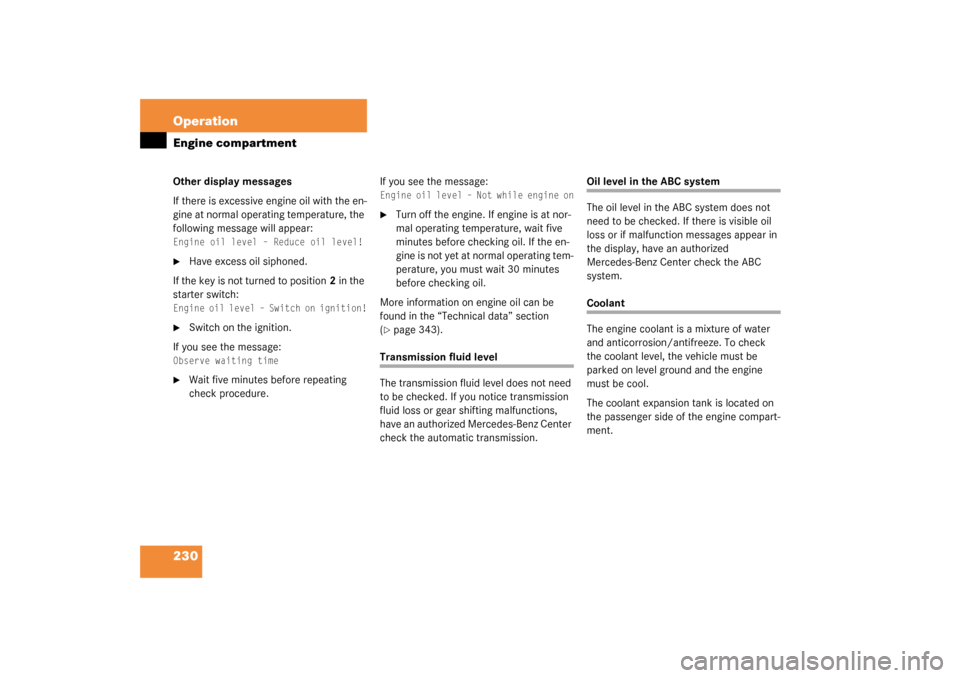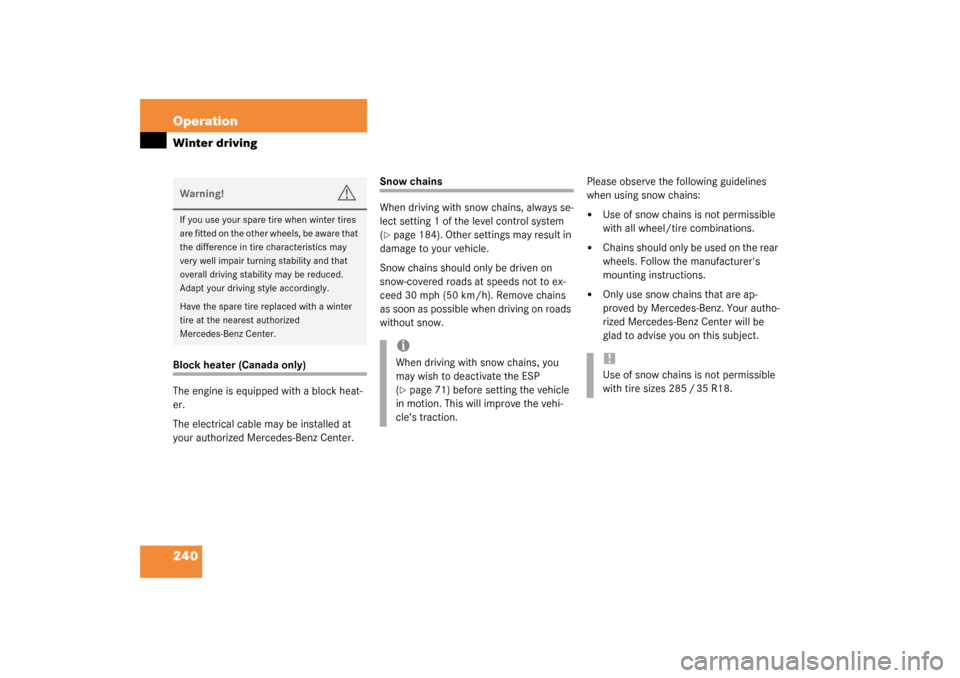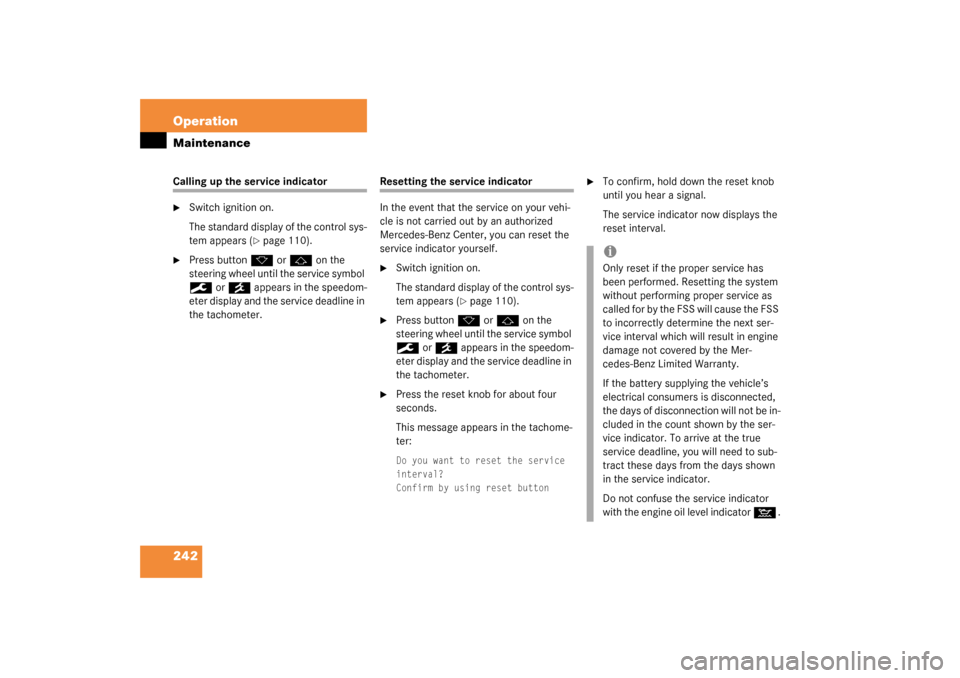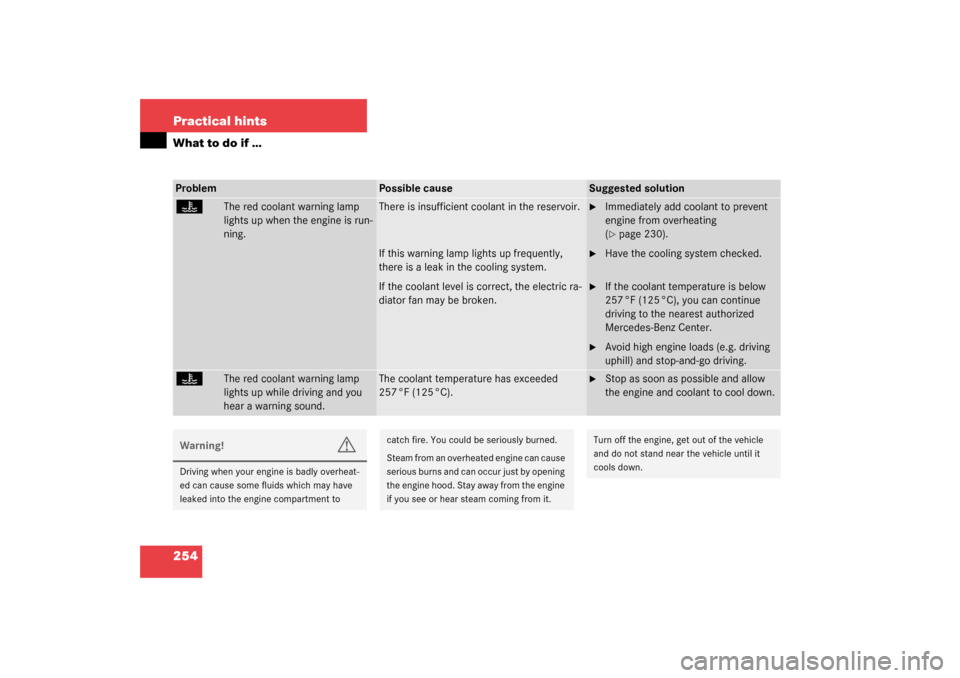Page 230 of 376

230 OperationEngine compartmentOther display messages
If there is excessive engine oil with the en-
gine at normal operating temperature, the
following message will appear: Engine oil level – Reduce oil level!�
Have excess oil siphoned.
If the key is not turned to position2 in the
starter switch:
Engine oil level – Switch on ignition!�
Switch on the ignition.
If you see the message:
Observe waiting time�
Wait five minutes before repeating
check procedure. If you see the message:
Engine oil level – Not while engine on�
Turn off the engine. If engine is at nor-
mal operating temperature, wait five
minutes before checking oil. If the en-
gine is not yet at normal operating tem-
perature, you must wait 30 minutes
before checking oil.
More information on engine oil can be
found in the “Technical data” section
(
�page 343).
Transmission fluid level
The transmission fluid level does not need
to be checked. If you notice transmission
fluid loss or gear shifting malfunctions,
have an authorized Mercedes-Benz Center
check the automatic transmission.
Oil level in the ABC system
The oil level in the ABC system does not
need to be checked. If there is visible oil
loss or if malfunction messages appear in
the display, have an authorized
Mercedes-Benz Center check the ABC
system.Coolant
The engine coolant is a mixture of water
and anticorrosion/antifreeze. To check
the coolant level, the vehicle must be
parked on level ground and the engine
must be cool.
The coolant expansion tank is located on
the passenger side of the engine compart-
ment.
Page 240 of 376

240 OperationWinter drivingBlock heater (Canada only)
The engine is equipped with a block heat-
er.
The electrical cable may be installed at
your authorized Mercedes-Benz Center.
Snow chains
When driving with snow chains, always se-
lect setting 1 of the level control system
(�page 184). Other settings may result in
damage to your vehicle.
Snow chains should only be driven on
snow-covered roads at speeds not to ex-
ceed 30 mph (50 km/h). Remove chains
as soon as possible when driving on roads
without snow. Please observe the following guidelines
when using snow chains:
�
Use of snow chains is not permissible
with all wheel/tire combinations.
�
Chains should only be used on the rear
wheels. Follow the manufacturer's
mounting instructions.
�
Only use snow chains that are ap-
proved by Mercedes-Benz. Your autho-
rized Mercedes-Benz Center will be
glad to advise you on this subject.
Warning!
G
If you use your spare tire when winter tires
are fitted on the other wheels, be aware that
the difference in tire characteristics may
very well impair turning stability and that
overall driving stability may be reduced.
Adapt your driving style accordingly.
Have the spare tire replaced with a winter
tire at the nearest authorized
Mercedes-Benz Center.
iWhen driving with snow chains, you
may wish to deactivate the ESP
(�page 71) before setting the vehicle
in motion. This will improve the vehi-
cle‘s traction.
!Use of snow chains is not permissible
with tire sizes 285 / 35 R18.
Page 242 of 376

242 OperationMaintenanceCalling up the service indicator�
Switch ignition on.
The standard display of the control sys-
tem appears (
�page 110).
�
Press button
k
or
j
on the
steering wheel until the service symbol
9
or
´
appears in the speedom-
eter display and the service deadline in
the tachometer.
Resetting the service indicator
In the event that the service on your vehi-
cle is not carried out by an authorized
Mercedes-Benz Center, you can reset the
service indicator yourself.�
Switch ignition on.
The standard display of the control sys-
tem appears (
�page 110).
�
Press button
k
or
j
on the
steering wheel until the service symbol
9
or
´
appears in the speedom-
eter display and the service deadline in
the tachometer.
�
Press the reset knob for about four
seconds.
This message appears in the tachome-
ter:Do you want to reset the service
interval?
Confirm by using reset button
�
To confirm, hold down the reset knob
until you hear a signal.
The service indicator now displays the
reset interval.iOnly reset if the proper service has
been performed. Resetting the system
without performing proper service as
called for by the FSS will cause the FSS
to incorrectly determine the next ser-
vice interval which will result in engine
damage not covered by the Mer-
cedes-Benz Limited Warranty.
If the battery supplying the vehicle’s
electrical consumers is disconnected,
the days of disconnection will not be in-
cluded in the count shown by the ser-
vice indicator. To arrive at the true
service deadline, you will need to sub-
tract these days from the days shown
in the service indicator.
Do not confuse the service indicator
with the engine oil level indicator
:
.
Page 254 of 376

254 Practical hintsWhat to do if …Problem
Possible cause
Suggested solution
D
The red coolant warning lamp
lights up when the engine is run-
ning.
There is insufficient coolant in the reservoir.
If this warning lamp lights up frequently,
there is a leak in the cooling system.
If the coolant level is correct, the electric ra-
diator fan may be broken.
�
Immediately add coolant to prevent
engine from overheating
(�page 230).
�
Have the cooling system checked.
�
If the coolant temperature is below
257 °F (125 °C), you can continue
driving to the nearest authorized
Mercedes-Benz Center.
�
Avoid high engine loads (e.g. driving
uphill) and stop-and-go driving.
D
The red coolant warning lamp
lights up while driving and you
hear a warning sound.
The coolant temperature has exceeded
257 °F (125 °C).
�
Stop as soon as possible and allow
the engine and coolant to cool down.
Warning!
G
Driving when your engine is badly overheat-
ed can cause some fluids which may have
leaked into the engine compartment to
catch fire. You could be seriously burned.
Steam from an overheated engine can cause
serious burns and can occur just by opening
the engine hood. Stay away from the engine
if you see or hear steam coming from it.
Turn off the engine, get out of the vehicle
and do not stand near the vehicle until it
cools down.
Page 258 of 376
258 Practical hintsWhat to do if …Left display
Right display
Possible cause
Possible solution
ABC
Drive carefully!
The capability of the ABC system is re-
stricted. This can impair handling.
�
Do not exceed a speed of 50 mph
(80 km/h).
�
Visit an authorized Mercedes-Benz Center
as soon as possible.
The vehicle is losing oil.
�
Stop your vehicle as soon as it is safe to do
so.
Stop, car too low
The car is parked on an extremely un-
even surface.
�
Press the vehicle level control button to se-
lect level 2 (
�page 184).
ABC is malfunctioning.
�
Stop and press the ABC button to select a
higher vehicle level (
�page 183).
�
Do not turn steering wheel too far to avoid
damaging the front fenders.
�
Listen for scraping noises.
�
Do not exceed a speed of 50 mph
(80 km/h).
�
Visit an authorized Mercedes-Benz Center
as soon as possible.
Page 266 of 376
266 Practical hintsWhat to do if …Left display
Right display
Possible cause
Possible solution
Except Canada:;Canada only:3
Reduced
brake effect
Visit workshop!
Incr.
braking dist.
Visit workshop!
The SBC brake system is in emer-
gency operation mode. Consider-
able brake pedal force is required
and the stopping distance is in-
creased.
�
Continue driving with added caution.
�
Visit an authorized Mercedes-Benz Center
immediately. Adjust driving to be consistent
with reduced braking responsiveness.
Brake fluid
below min. level!
Visit workshop!
There is insufficient brake fluid in the
reservoir.
�
Risk of accident! Stop the vehicle and notify
an authorized Mercedes-Benz Center. Do
not add brake fluid! This will not solve the
problem.
!If you find that the brake fluid in the
brake fluid reservoir has fallen to the
minimum mark or below, have the
brake system checked for brake pad
thickness and leaks.
Page 279 of 376
279 Practical hints
What to do if …
Left display
Right display
Possible cause
Possible solution
.
Light sensor
Visit workshop!
The light sensor is malfunctioning.
The headlamps switch on automati-
cally.
�
In the control system, set lamp operation to
manual (
�page 124).
�
Switch on headlamps using the exterior lamp
switch.
?
Visit workshop!
There may be a malfunction in the �
fuel injection system
�
ignition system
�
exhaust system
�
fuel system
�
H a v e t h e e n g i n e c h e c k e d a s s o o n a s p o s s i b l e
by an authorized Mercedes-Benz Center
(�page 256).
O
Close hood!
You are driving with the hood open.
�
Close the hood (
�page 228).
:
Engine oil level
Stop, engine off!
There is no oil in the engine. There is
a danger of engine damage.
�
Carefully bring the vehicle to a halt as soon
as possible.
�
Turn off the engine.
�
Add engine oil.
Page 312 of 376

312 Practical hintsFlat tireMounting the spare wheel Preparing the vehicle
Prepare the vehicle as described above
(
�page 302).
�
Turn spare wheel bracket counter-
clockwise to loosen.
�
Take the wheel out of the trunk.
Lifting the vehicle
�
Prevent the vehicle from rolling away
by blocking wheels with wheel chocks
(not included) or other sizable objects.
When changing wheel on a level sur-
face:�
Place one chock in front of and one
behind the wheel that is diagonally
opposite to the wheel being
changed.
When changing wheel on a hill:
�
Place chocks on the downhill side
blocking both wheels of the other
axle.
�
Take the vehicle tool kit and the jack
out of the storage compartment under
the trunk floor (
�page 289).
Warning!
G
The dimensions of the spare wheel are dif-
ferent from those of the road wheels. As a
result, the vehicle handling characteristics
change when driving with a mounted spare
wheel. Adapt your driving style accordingly.
The spare wheel is for temporary use only.
When driving with spare wheel mounted, en-
sure proper tire pressure and do not exceed
vehicle speed of 50 mph (80 km/h).
Drive to the nearest Mercedes-Benz Center
as soon as possible to have the spare wheel
replaced with a regular road wheel.
Never operate the vehicle with more than
one spare wheel mounted.
Warning!
G
The jack is designed exclusively for jacking
up the vehicle at the jack tubes built into
both sides of the vehicle. To help avoid per-
sonal injury, use the jack only to lift the ve-
hicle during a wheel change. Never get
beneath the vehicle while it is supported by
the jack. Keep hands and feet away from the
area under the lifted vehicle. Always firmly
set parking brake and block wheels before
raising vehicle with jack.
Do not disengage parking brake while the
vehicle is raised. Be certain that the jack is
always vertical (plumb line) when in use, es-
pecially on hills. Always try to use the jack
on level surface. Be sure that the jack arm is
fully inserted in the jack tube. Always lower
the vehicle onto sufficient capacity jack-
stands before working under the vehicle.